Lessons & Units
A database
of lessons and units searchable by content and cultural standards,
cultural region and grade level. More units will be available soon.
You can use Acrobat Reader to look at the PDF version of the Cover
Sheet
for the Units and Self-Assessment
for Cultural Standards in Practice.
DIGGING AND
PREPARING
SPRUCE ROOTS
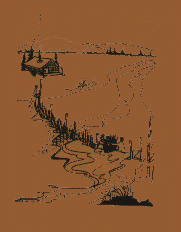
By Alan & Helen Dick
The Iditarod Area School District
McGrath, Alaska
1998
DIGGING
AND PREPARING
SPRUCE
ROOTS
DIGGING SPRUCE
ROOTS
The old-timers used spruce roots for many purposes. Roots are
tough, do not stretch, hold a knot well, and are free for the
digging. However, knowledge is required to get them and to do a good
job with them.
The old-timers had many uses for spruce roots. Anything that we
use string for today, the old-timers used either roots or babiche.
Roots are better than babiche in applications where the object would
be in water, as wet babiche stretches terribly. Babiche is much
stronger in dry applications.
Fish traps were always lashed with spruce roots. The lashing does
not stretch, does not rot for many years when well cared for, and is
strong enough. Roots do not hurt a person's hands when the fish trap
is being cleaned as nails do.
|
Bark baskets were lashed with roots. The stiff roots hold
shape and, do not require a needle to thread through the
holes. They are stronger than the bark, so they do not
break. Many times poles and sticks were lashed together with
roots. On smokehouses, bark canoes, and hand tools, parts
were joined by roots.
|

|
The first and hardest part, it seems, is finding a good place to
dig the roots. When the old-timers found a good place, they often did
not tell anyone else because good places are hard to find. If the
roots are too deep in the soil, they are hard to dig. If they are
mixed with birch, willow and alder roots, they are hard to untangle.
It is best to invest a little time looking for a good place among
spruce stands. Look for a place that has a nice moss floor, with
relatively little brush. Dig around and see how many spruce roots
there are and how deep they are. You might have to try several places
until you find a good one. Travel by boat is the best.
Telling what's under from up
above
How can you tell what the roots will be like? Trees are just like
people; they are different from each other. Some are tough and some
are not. Some are short and wide; others are long and slim. How can
you tell what the roots will be like? The roots will be like the
trunk and branches of the tree.
|

|
If the tree is tall with little taper, then the roots
will be long with little taper. If the tree has many
branches, then the roots will have many forks and
branches.
|
|

|
If the branches are tough and hard to break off, then the
roots will be tough and hard to break.
|
We can tell how the roots will be by the rest of the tree. We want
roots that are long, have little taper, few branches, and are tough.
We do not want short roots that are easy to break.
Method of digging
What is the best way to dig the roots?
The old timers used a stick shaped like this:

Nowadays we often use a hammer.

When we have enough roots, we coil them up together, and try to
keep them from drying

While digging roots, it is often hard to tell a spruce root from
those of birch, cottonwood or willow, as they are interwoven under
the moss. If they look too much alike to tell them apart, smell or
taste them. Spruce is quite different from the others.
Some people get roots from a cutbank where they are hanging down
free from dirt. This is ok, but often the roots are very dry and take
a long time to soak and soften. Also, it is hard to remove the bark
from them. Old-timers used roots from cutbanks when the land was
frozen in spring and fall and they were the only roots available.
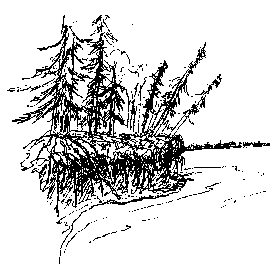
CLEANING THE ROOTS
The time of year roots are harvested determines if the job is easy
or hard. Roots dug when the bark slips easily off the trees will also
peel very easily (June-July). Roots dug in spring and fall will be
harder to bark, but certainly not impossible. Cleaning roots is far
easier than digging them.
Step 1) Cut off all the small root hairs with a pocket
knife.
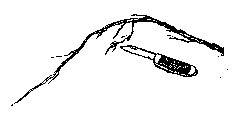
Step 2) Remove the bark. There are several ways
to do this.
The old-timers often split a small stump (about 2"-3") with an axe.
They pulled the root through the crack, starting with the big end of
the root. This works well, but the crack soon plugs up with bark, and
needs to be cleaned out with a stick.
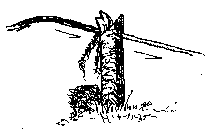
Another method is to split a dry spruce stick about ten inches
long then tie the top of the two halves back together again. Put the
root between the two halves, and squeeze the bottom together creating
just the right pressure to scrape the bark from the roots. This way
is good because it is easy to clean the bark from between the two
sticks.
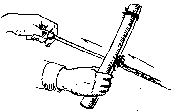
A more modern way is to pull the roots through the claws of a
framing hammer. The bark slips off easily. Cleaning the hammer claws
is not a problem.

Step 3) Split the roots
After the roots have been stripped of their bark and root hairs,
they need to be split. This is not hard, and is even fun when the
method is learned. Most roots have a dark line or dent in their
surface. Start the split with a knife or teeth along this line.

Hold one side of the split in your mouth, and the other side of
the split in one hand, placing the other as shown in the picture
below.
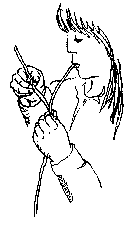
The trick is to keep the split pieces equal in thickness. If one
side gets too thick, end the thick side so stress on the fibers
causes them to split over to the thin side. Keep the thin side
straight.
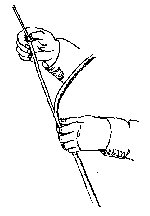
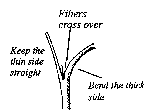
Once you master this, there is nothing hard to splitting roots.
You will also be able to split willows, and any other kind of brush.
When teaching students we often let them practice splitting willows
as they are easier to gather than roots.
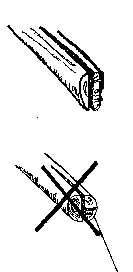
If they are split in quarters like the above root, the lashing
will not lay flat on the workpiece.

Tying roots together
There is only one knot that works well tying the roots
together.
The big end should be used to make the "V", and the little end of the
root to tie around it. Look at the drawing, and practice the knot
until you master it.
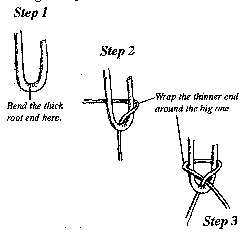
Now that you have found the roots, cleaned them, and split them,
you can make many traditional crafts. After the ground is frozen,
there is a sense of wealth when you have a supply of roots hidden
away. Perhaps you will make a birch basket for a present. Maybe you
will give roots to an elder.
Whether you have a supply of roots or not, the knowledge of how to
find and prepare them will be with you for the rest of your life.
Handbook
for Culturally Responsive Science Curriculum by Sidney Stephens
Excerpt: "The information and insights contained in this document will be
of interest to anyone involved in bringing local knowledge to bear in school
curriculum. Drawing upon the efforts of many people over a period of several
years, Sidney Stephens has managed to distill and synthesize the critical ingredients
for making the teaching of science relevant and meaningful in culturally adaptable
ways." |